

© Shipping Wonders of the World 2012-

Ship to Shore Communication
Wireless is no longer regarded merely as a means of summoning assistance in an emergency. It is an invaluable aid to navigation, and its use does much to reduce the possibility of accidents. It is still the principal means by which a ship can communicate beyond her visible horizon
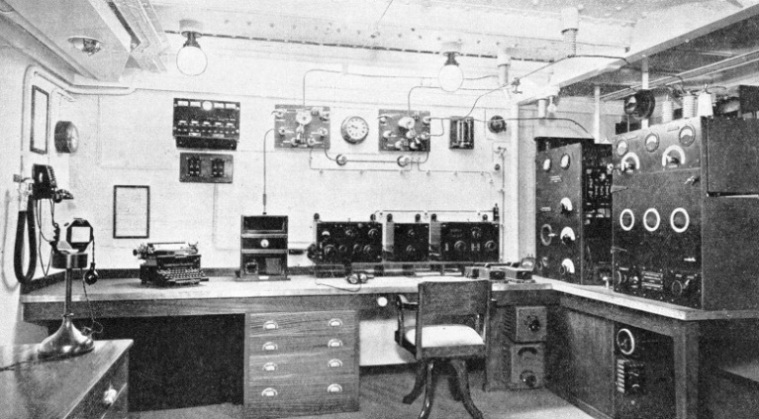
ALL CONTINENTS ARE WITHIN CALL of the modern ship’s wireless installation. Ships that are equipped for medium-
THE first practical use to which wireless telegraphy was put was as a means of communication between ships at sea and the mainland. Although wireless has developed beyond all recognition, marine communications are still its most important application.
Broadcasting services and transmissions of all types are of tremendous importance on land, but they could all be replaced by wire circuits. For the ship at sea, wireless is the principal means of establishing communication with points beyond the visible horizon.
Before the use of wireless, inter-
An Italian scientist named Guglielmo Marconi came to England in 1896, took out the first patent for wireless telegraphy, and brought his apparatus to the notice of the Engineer-
As it was clear that ordinary telegraphic signalling presented more difficulties at sea than on land, it became certain that the sea was the natural field for the development of the new invention.
In 1897, ranges of twelve miles were attained during a series of experiments carried out in Italian warships at Spezia, in the Gulf of Genoa.
The first ship to be fitted with a permanent wireless installation was the East Goodwin lightship, which was equipped by Marconi for communication with the South Foreland lighthouse in 1898. The lightship was rammed by the steamer Matthews in the following year, but the crew was rescued — thanks to a wireless report sent at once to the shore station. At the earliest stage of its development, therefore, wireless was able to prove its value as a means of saving life and safeguarding property.
The particular installation that made history in this way was capable only of communicating with one fixed station at a distance of a few miles. To-
Ships are enabled to keep in touch with one another, and with coastal stations, and thereby to determine their positions. They are also kept supplied with regular information relating to bad weather conditions that may be approaching. Time signals are available, enabling ship’s chronometers to be checked to a high degree of accuracy. Medical advice may be sought without loss of time. All these services are of vital importance, and yet they comprise only a small fraction of the vast organization which is included in the title of “ship-
It had been discovered before the war that it was possible to determine the direction from which a wireless signal was being transmitted. The frequent location of enemy submarines by this means was one of the immediate results. The possibility that a ship would, in the future, be able to determine her own position by another application of the same principle was not fully realized until some years later.
To-
They may also determine the depth of water under the ship, by means of instruments, such as echometers, working on principles closely allied to that of wireless, and, by one of the most recent applications, they may receive visible and audible warning of the presence of an obstruction in darkness or in thick fog.
All these aspects of wireless affect chiefly the master of the ship and the crew. The passengers’ safety, it is true, is concerned with every one of them, but it is doubtful whether the passengers realize all that wireless is doing for them. They appreciate it as a means of communicating with friends on shore and as the medium by which their daily news-
Shipowners are no longer reactionaries where wireless is concerned. They realize that it is better, and cheaper, by means of scientific aids to render disaster improbable than to develop costly and cumbrous means of saving life when trouble does occur. There must always be lifeboats and rafts, but every oceangoing vessel fitted with wireless is a potential lifeboat, equipped with every device calculated to assure not only her own safety, but also that of other vessels which may be in difficulties.
It is now compulsory for all passenger-
Obtaining Bearings in Fog
The larger ships can make use of the automatic radio beacons, of which there are over 200 in the world, twenty-
Normally the signals are sent out every half-
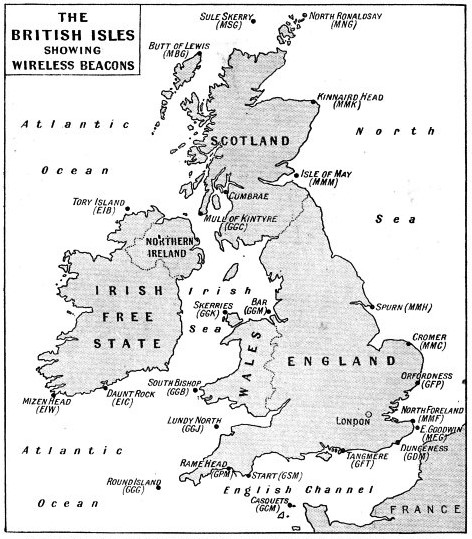
AUTOMATIC WIRELESS BEACONS are located at twenty-
The beacon stations round the British Isles are operated by Trinity House, by the Northern Lighthouse Board and by the Irish Lights Commissioners. A map showing their locations and call-
A further contribution to safety at sea is the auto-
It is also a reversible device which may be set to transmit a distress call, should the need arise. In its most modern form it will respond to the distinctive alarm signal, even through the heaviest interference and atmospherics, but not to any other type of signal. Its use was legalized at the International Convention for Safety of Life at Sea, held in 1929, and it has greatly eased the burden of watching in ships which carry only one wireless operator. About 1,200 ships in the British Mercantile Marine are fitted with the auto-
The procedure followed when a distress call is intercepted is one which involves the least possible loss of time. The signal SOS is transmitted, followed by particulars of the ship, her position and the difficulties in which she is. The nearest coast station intercepting such a signal immediately ceases all other work and attempts to communicate with the ship. It often has also to “close down” several other ships and coastal stations which may be interfering with its reception.
So efficiently is this carried out, however, that silence soon prevails upon the particular wave-
It is an international rule that the distress call shall be transmitted only on the authority of the master, or person responsible for the ship.
Broadcast Warnings
Second in importance to the distress service ranks the urgency or priority service, whereby communications from vessels disabled or in difficulty, but not in immediate danger, are given precedence over all others except SOS. A special urgency signal (XXX) precedes the transmission of such messages, and occurrences necessitating the use of this signal, as well as those requiring the distress signal, are classed as “ casualty cases.” Coastal stations round the British Isles handle approximately 150 of these “casualty cases” in a year.
Another branch of what may be termed the “safety service” is also handled by the coast stations. This consists of broadcast warnings to all shipping. Broadcast on behalf of the Admiralty, navigation warnings advise vessels of changes or faults in navigating lights and buoys. Such warnings are broadcast also by the B.B.C. Gale warnings, issued by the Meteorological Office, are broadcast both by the coastal stations and by the B.B.C.
In 1919 the Marconi Company designed apparatus for use in ship’s lifeboats. This development was an important contribution to the safety service, since it meant that the sinking of a ship would not imply the breaking of all means of communication between the survivors and the mainland or another ship. For certain classes of ships the installation of wireless in lifeboats was made compulsory in 1924, and nearly 400 lifeboats are now equipped with wireless apparatus. Using a wavelength of 600 metres, their sets have a working range of about 300 miles.
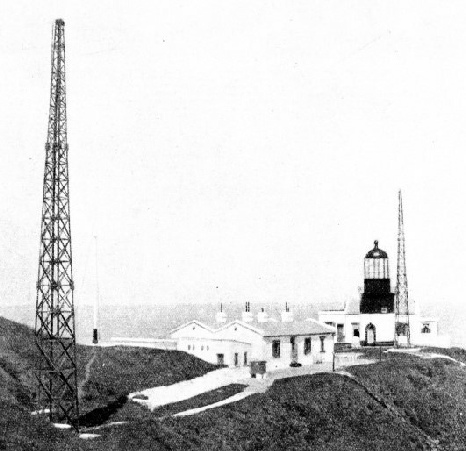
INVALUABLE DURING FOGGY WEATHER, the many wireless beacons throughout the world are an important contribution to safety at sea. The installation shown is at North Saddle, China, but in appearance it is typical of the beacons round the coast of the British Isles, most of which are combined with coastguard stations or lighthouses.
Illnesses and ailments in a ship that does not carry a doctor can generally be treated by a resourceful captain; serious illnesses, however, may necessitate the sending of an urgent message to another ship or to a shore station. Such telegrams are sometimes sent in plain language, but a special code has been devised for the purpose. By means of this, a telegram coded in one language may be decoded into an accurate translation in a large number of other languages — an important matter where medical advice is concerned. It is also possible for the ship’s doctor, if one is carried, to hold consultations by wireless with specialists ashore.
Ship-
Before 1919 nearly all ships were equipped with spark apparatus, the only merits of which were cheapness and simplicity. The average spark signal was broadly tuned and caused serious interference, at close quarters, over a wide band of wavelengths. Since 1927, when the International Radiotelegraph Conference was held in Washington, all transmitters with a rating in excess of 300 watts have been of the valve type. Receiving apparatus of the valve type, however, was used for some time before 1927, on account of the obvious limitations of the crystal and earlier types of receiver.
The standard valve receiver supplied to shipping by the Marconi Company was built in three units—a receiver tuning from 180 to 3,000 metres, a long-
Most of the safety services are handled, nowadays, on the 600 to 800-
Traffic services, fortunately, make far greater use of the ether than do the safety services, which, though unquestionably the most important users of wireless, do not occupy the ether as often as the others.
The most frequent type of message passing between ships and shore is the ordinary radio-
Passengers’ business affairs are also largely concerned, and the remainder of the traffic consists of trivial social messages. In the course of handling routine traffic, shore stations receive a large amount of information concerning the position and movements of ships. Such information is forwarded to Lloyd’s by the coastal stations.
Long-
Such stations are so arranged that their reliable ranges overlap considerably. A small ship proceeding coastwise may thus remain continuously in touch with her owners or with a point on shore. A larger ship, with more powerful equipment, may establish communication with her destination before her voyage has begun. Ships on the North Atlantic route can communicate with Canada and with the United States while they are still in Southampton Water, and their transmissions are frequently heard in Great Britain while the ships are within sight of the American coast.
Ship-
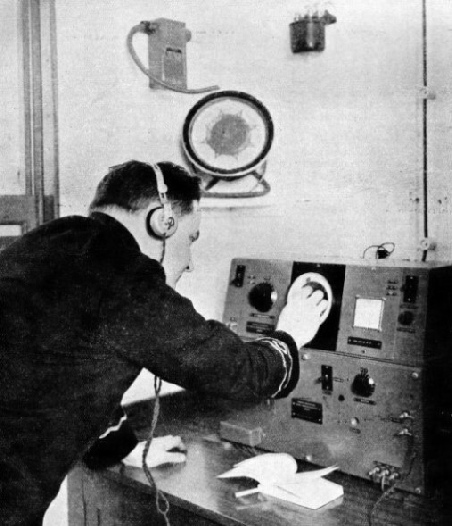
DIRECTION-
Telephony is used, however, also by many small trawlers, for the trawler skipper generally operates the wireless set himself, and he is not a trained operator, nor does he always know the Morse code. The telephony equipment in such vessels is designed especially for use by unskilled operators, and is provided with the minimum number of adjustments and complications.
Many lightships also are fitted with small telephony installations, and interesting (and sometimes amusing) conversations between lightships and trawlers may often be intercepted in the 150-
There is a great demand for the smaller and cheaper type of telephone apparatus, which, with ratings of 300 and 60 watts, will cover reliable ranges of from 200 to 500 miles. The sets are compactly built, easily handled, and may be used also for telegraphic working, which increases their range still more.
Wavelengths between 109 and 230 metres are used for telephony, and telegraphy is transmitted on 220 metres or on the 600-
This means that a trawler in difficulties is not confined to communication with similar ships using the same band of wavelengths, but can speedily summon assistance from a coastal station or from one of the enormous number of ships keeping watch on the 600-
At the other extreme in the scale of power, however, comes the great station at Rugby, one of the functions of which is to transmit special telegraph services of a broadcast nature. Long press messages (British Official Press and “Shipress”) are transmitted every day, chiefly to furnish news in the daily papers and news sheets published in the larger ships. Time signals, directly controlled by Greenwich Observatory, are also transmitted from Rugby, with meteorological messages. This station’s long-
Coastal Stations
By an agreement between the Marconi Company and the General Post Office, the Rugby station is used to bring all ships under Marconi control into action when it is necessary to get an urgent message through to a ship which is difficult to reach by the ordinary methods.
Rugby is essentially a high-
At Burnham Radio, however, the receivers are separated from the transmitters (which are at Portishead, Somerset) by a distance of twenty-
The transmitters at Portishead are remotely operated from the control point at Burnham, which also handles the telephone and telegraph lines for distributing the traffic over the land system of communications.
The Portishead transmitting station houses one telephony transmitter for the small coasting vessels, one telegraph transmitter for coastal and medium-
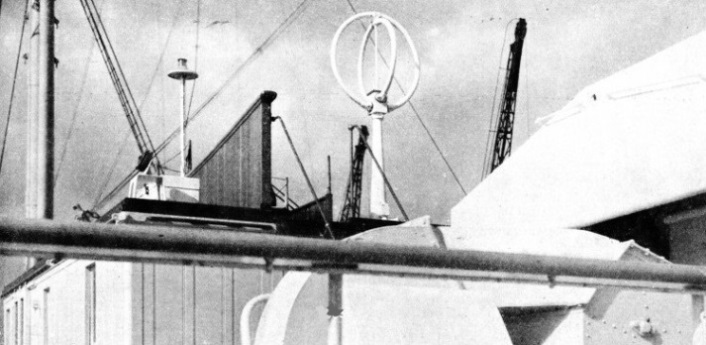
THE DIRECTION-
At Burnham there are nine shortwave receivers, which enable all the main shipping routes to be covered. There are also three receivers for the medium-
More than 150 ships communicate with Burnham every day, and reliable contact is maintained with ships in the most distant parts of the world. Indeed, the range of the station is world-
A development which has been necessitated by the increasing complication of wireless apparatus is the provision of skilled technical men at most of the important ports. Many difficult problems arise in connexion with modern equipment, and careful inspections of the ship’s gear must be carried out at regular intervals.
The increasing use of electrical machinery on board the larger ships has led to special difficulties with the wireless apparatus. Electric lifts, generators, fans and motors all have a marked effect upon a sensitive wireless receiver, especially when it cannot be placed in a particularly favourable position in the ship.
Electrical noises have been traced to revolution counters, gyro compasses, screen-
Stays and funnel guys often cause interference with a short-
Special problems have to be faced in the designing of apparatus which has to withstand not only the influence of a salt atmosphere, but also the effects of great variations in temperature. In the Red Sea in summer, for example, the atmosphere is extremely humid, and special measures must be taken to keep the gear dry.
Robustness and Reliability
Materials have to be evolved which will remain unaltered in size under extreme changes of temperature, and, in effect, another vast “shore staff” is constantly at work in the laboratories, safeguarding the lives of those who rely on the provision of reliable apparatus.
In large liners the passengers’ telephone service must be capable of operating simultaneously with the ship’s telegraphic service. This has necessitated the building of transmitters which have a high degree of accuracy and stability in all conditions. Two. or even three cabins are necessary for the separation of the various transmitting and receiving units in these large ships.
A modern direction-
The ability to convey ordinary intelligence and information and to obtain prompt assistance in time of need is also contributory to safe navigation, and in these ways — apart from the aspect of direction-
Development continues apace, and the possibilities of television as an aid to shipping have yet to be explored. The last word in wireless communication can never be uttered; but wireless will always be regarded as one of the greatest blessings that have ever been conferred upon those who go down to the sea in ships.
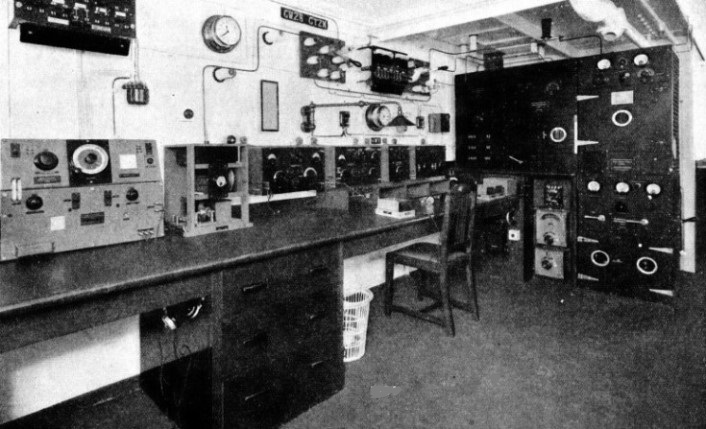
A TYPICAL MODERN INSTALLATION in the Athlone Castle (25,564 tons gross). On the left is the direction-
You can read more on “Distant Signalling at Sea”, “The Modern Ships Wireless” and
“The Work of Trinity House” on this website.